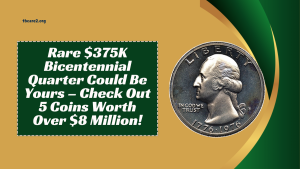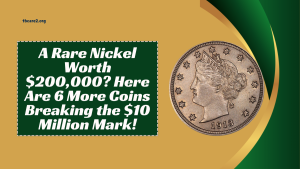The 1976 Bicentennial Quarter is much more than just a coin—it’s a treasure for collectors and an iconic piece of American history. Minted to mark the 200th anniversary of the United States’ independence, these quarters have become highly coveted collectibles.
While millions were produced, some rare error versions of the Bicentennial Quarter have been appraised at extraordinary values—some even reaching as high as $2.2 billion!
This guide will help you understand the Bicentennial Quarter’s value, how to identify rare finds, and why this piece of currency is still relevant today
Contents
A Coin to Celebrate America’s Bicentennial
The Bicentennial Quarter holds deep significance for the United States, as it was minted to commemorate the 200th anniversary of U.S. independence in 1976. Not just a regular piece of currency, this coin symbolized the patriotism of the Revolutionary War era.
The quarter’s design features a colonial drummer on the reverse side, symbolizing the unity and patriotism of the era, while the obverse displays the dual date “1776-1976”—signifying the 200-year milestone of American freedom.
Unique Features of the Bicentennial Quarter
The Bicentennial Quarter was created as a limited-edition series for collectors, setting it apart from typical U.S. quarters. The obverse side showcases a portrait of George Washington with a significant historical design.
Some key aspects that set the Bicentennial Quarter apart from other coins are:
- Dual Date: “1776-1976” boldly inscribed to celebrate the bicentennial.
- Colonial Drummer Design: Featured on the reverse side with 13 stars, representing the original 13 colonies.
The Fascination with Rare Error Variants
Though millions of Bicentennial Quarters were produced, some rare minting errors significantly increase their value, with estimates soaring to $2.2 billion in extreme cases. Here’s a look at common errors:
- Misalignments: When the coin’s design is not correctly aligned, leading to a distorted image.
- Double Dies: Coins with duplicated elements on their design, typically noticeable in the text or the image of the colonial drummer.
- Other Anomalies: These include uneven edges or overstrikes that make the coin one-of-a-kind.
These error coins are highly sought after and can fetch astronomical prices depending on the condition and rarity of the mistakes.
How to Identify a Rare Bicentennial Quarter
Identifying a rare Bicentennial Quarter involves careful inspection for its distinctive features:
Key Design Features
- Ensure the coin displays the “1776–1976” inscription.
- The reverse should feature the colonial drummer design surrounded by 13 stars.
Minting Errors
- Misalignments: Look for any designs that appear off-center or poorly aligned.
- Double Dies: Examine the text and design for any doubling, especially in the wordings or features.
Material Composition
- The 40% silver variants are more valuable than their copper-nickel counterparts. These silver editions are highly collectible.
Condition
- Coins in uncirculated or mint condition command significantly higher prices than those that show wear.
| Feature | Details |
|---|---|
| Year of Minting | 1976 |
| Purpose | Celebrating the 200th anniversary of U.S. independence |
| Design Highlights | Dual date “1776–1976” and a colonial drummer design |
| Minting Errors | Misalignments, double dies, and other anomalies |
| Estimated Value | Up to $2.2 billion for rare error variants |
| Significance | Historical importance and unique design |
| Material Composition | Includes standard and 40% silver variants |
Why Is the Rare Bicentennial Quarter So Valuable?
Several factors contribute to the value of the Rare Bicentennial Quarter:
- Historical Importance: Celebrating 200 years of U.S. independence, these quarters hold immense historical value.
- Unique Design: The colonial drummer and dual-date make this coin stand out in U.S. coinage.
- Scarcity of Errors: Error variants are incredibly rare, with only a handful making it to circulation.
- Connection to Cultural Heritage: The coin represents a national milestone, making it a cherished collectible.
Tips for Aspiring Coin Collectors
If you’re keen on starting your collection or suspect that you have a rare Bicentennial Quarter, here are a few tips:
- Check Your Pocket Change: Rare coins occasionally resurface in circulation, so always be on the lookout.
- Handle with Care: Use gloves to prevent oils and dirt from damaging the coin.
- Join Numismatic Communities: Networking with other collectors can offer insight into rare finds.
- Consult Experts: If you suspect your coin could be rare, seek the help of professional appraisers or numismatics services for authentication.
The Rare Bicentennial Quarter is much more than a commemorative coin; it’s a collector’s treasure. Its historical significance, unique design, and the scarcity of minting errors make it a highly prized asset.
Whether you are a seasoned coin collector or just beginning your numismatic journey, understanding the value of this coin and knowing how to spot rare variants will help you make informed decisions. Keep an eye on your pocket change, handle your coins with care, and consult experts to maximize the value of your Bicentennial Quarter collection.
What makes the 1976 Bicentennial Quarter so special?
The Bicentennial Quarter commemorates the 200th anniversary of U.S. independence and features a unique colonial drummer design and the dual-date “1776-1976.”
What is the value of a Bicentennial Quarter in circulation?
The value can range from face value for common versions to $2.2 billion for rare mint error variants.
How can I tell if my Bicentennial Quarter is rare?
Look for minting errors, such as double dies, misalignments, and uneven edges. Also, check if it is made of 40% silver, which increases its value.






